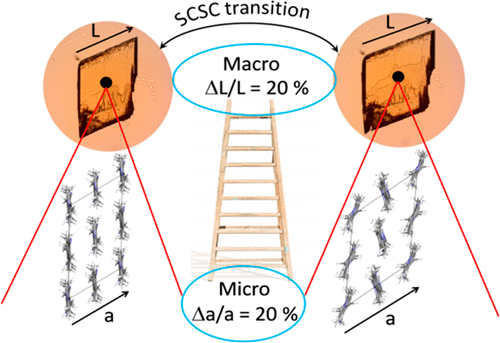当前位置:
X-MOL 学术
›
Cryst. Growth Des.
›
论文详情
Our official English website, www.x-mol.net, welcomes your
feedback! (Note: you will need to create a separate account there.)
Translating Microscopic Molecular Motion into Macroscopic Body Motion: Reversible Self-Reshaping in the Solid State Transition of an Organic Crystal
Crystal Growth & Design ( IF 3.2 ) Pub Date : 2018-05-08 00:00:00 , DOI: 10.1021/acs.cgd.8b00337 Roberto Centore 1 , Mauro Causà 2
Crystal Growth & Design ( IF 3.2 ) Pub Date : 2018-05-08 00:00:00 , DOI: 10.1021/acs.cgd.8b00337 Roberto Centore 1 , Mauro Causà 2
Affiliation

|
The amplification of microscopic molecular motions so as to produce a controlled macroscopic body effect is the main challenge in the development of molecular mechanical devices. That amplification requires the coherent and ordered movement of each molecule of a whole macroscopic set, such as that taking place in a single-crystal-to-single-crystal transition. Actually, single-crystal-to-single-crystal transitions in molecular crystals can produce a variety of mechanical effects potentially useful in the development of smart materials. A challenging issue in these dynamic crystals, propedeutic to many possible applications in devices, is the gaining of a strict control over the mechanical effects associated with the transition. Here we report an example in which the control of the mechanical effects was successfully obtained. The compound studied undergoes a reversible single-crystal-to-single-crystal transition at 71 °C, from a planar stacked to a herringbone type packing. To this transition, a reversible macroscopic self-reshaping of the crystal is associated. Depending on the morphology, the crystal specimen undergoes a reversible longitudinal expansion of about 20% or a reversible transverse expansion of 20%, the other two dimensions of the crystal specimen being substantially unchanged. The amount of the macroscopic reshaping effect (20%) fully matches the relative variation of the sole unit cell parameter that changes during the transition (from 8.139 to 9.666 Å) in a sort of scale-invariant process. This represents striking evidence of controlled translation of sub-nanometer molecular motions up to the macroscopic scale of body motion.
中文翻译:

将微观分子运动转化为宏观身体运动:有机晶体固态转变中的可逆自重塑
微观分子运动的放大从而产生受控的宏观身体效应是分子机械装置发展中的主要挑战。这种放大需要整个宏观集合中每个分子的连贯而有序的运动,例如发生在单晶到单晶转变中的运动。实际上,分子晶体中从单晶到单晶的转变会产生各种机械效应,这些效应可能对智能材料的开发很有用。这些动态晶体的一个挑战性问题是对设备中许多可能的应用有帮助的问题是,必须严格控制与过渡相关的机械效应。在这里,我们报告一个示例,其中成功获得了机械效果的控制。研究的化合物在71°C下经历了可逆的单晶至单晶转变,从平面堆叠到人字形填料。为了实现这一转变,需要对晶体进行可逆的宏观自整形。取决于形态,晶体样品经历约20%的可逆纵向膨胀或20%的可逆横向膨胀,晶体样品的其他两个尺寸基本不变。宏观重塑效果的量(20%)完全匹配唯一的单位晶胞参数的相对变化,该变化在某种尺度不变的过程中会发生变化(从8.139到9.666Å)。这代表了亚纳米分子运动直至身体运动的宏观尺度受控转换的惊人证据。
更新日期:2018-05-08
中文翻译:

将微观分子运动转化为宏观身体运动:有机晶体固态转变中的可逆自重塑
微观分子运动的放大从而产生受控的宏观身体效应是分子机械装置发展中的主要挑战。这种放大需要整个宏观集合中每个分子的连贯而有序的运动,例如发生在单晶到单晶转变中的运动。实际上,分子晶体中从单晶到单晶的转变会产生各种机械效应,这些效应可能对智能材料的开发很有用。这些动态晶体的一个挑战性问题是对设备中许多可能的应用有帮助的问题是,必须严格控制与过渡相关的机械效应。在这里,我们报告一个示例,其中成功获得了机械效果的控制。研究的化合物在71°C下经历了可逆的单晶至单晶转变,从平面堆叠到人字形填料。为了实现这一转变,需要对晶体进行可逆的宏观自整形。取决于形态,晶体样品经历约20%的可逆纵向膨胀或20%的可逆横向膨胀,晶体样品的其他两个尺寸基本不变。宏观重塑效果的量(20%)完全匹配唯一的单位晶胞参数的相对变化,该变化在某种尺度不变的过程中会发生变化(从8.139到9.666Å)。这代表了亚纳米分子运动直至身体运动的宏观尺度受控转换的惊人证据。











































 京公网安备 11010802027423号
京公网安备 11010802027423号